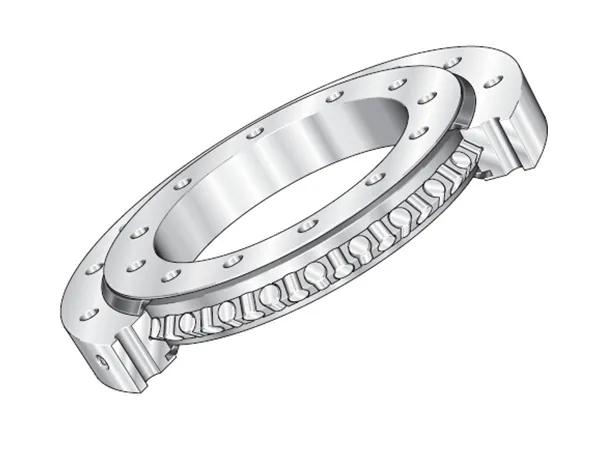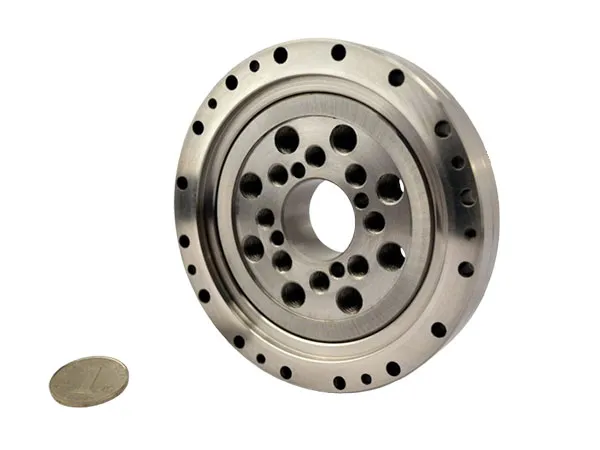Precision crossed roller bearings are critical components in applications requiring high rigidity, accuracy, and the ability to handle combined loads (radial, axial, and moment loads). Proper lubrication is paramount to their performance, longevity, and overall system reliability.

Reduces Friction and Wear: Creates a lubricating film between rolling elements and raceways, minimizing direct metal-to-metal contact.
Extends Fatigue Life: A proper lubricant film reduces stress concentrations and prevents surface damage, thereby prolonging the bearing's operational life.
Dissipates Heat: Helps to carry away heat generated by friction, preventing overheating and material degradation.
Prevents Corrosion: Forms a protective barrier against moisture, contaminants, and corrosive agents.
Damping and Noise Reduction: The oil film can absorb some energy, contributing to smoother operation and reduced noise.
Sealing: Grease, in particular, can act as a barrier to prevent the ingress of dust, dirt, and moisture.
The two main types of lubricants used for precision crossed roller bearings are grease and oil. The choice depends heavily on the specific application's operating conditions (speed, load, temperature, environment).
Grease Lubrication:
Advantages: Adheres well to surfaces, lasts longer, provides good sealing against contaminants, and is often preferred for applications where easy access for re-lubrication is limited.
Types:
Lithium-based greases: Commonly used, offering good performance in high-load applications and good corrosion stability.
Synthetic greases: May be used for specific temperature ranges (e.g., silicone oil-thickened for low temperatures, synthetic greases for higher temperatures).
Avoid: Greases with solid additives like MoS2 (molybdenum disulfide) or PTFE (Teflon) unless specifically recommended by the bearing manufacturer.
Considerations: Consistency (NLGI grade) is important, as it affects how the grease flows within the bearing.
Oil Lubrication:
Advantages: Better at dissipating heat, suitable for higher speeds and lighter to medium loads, and can be circulated for continuous cooling and filtration.
Types:
CLP oils (e.g., DIN 51519): Common industrial gear oils.
HLP oils (e.g., DIN 51524): Hydraulic oils with additives for improved wear protection.
Considerations: Mounting orientation can be a factor, as oil can drip in vertical or sideways applications. Viscosity is crucial and should be sufficient to form a load-supporting film at operating temperature.

Operating Temperature: The lubricant's properties (especially viscosity and dropping point for grease) change with temperature. Ensure the lubricant's operating temperature range is suitable for your application.
Loads: Higher loads generally require lubricants with higher viscosity (for oil) or lower penetration (for grease) to maintain a strong lubricating film. Greases with EP (extreme pressure) characteristics are suitable for high loads.
Rotation Speed: High speeds generate more friction and heat, often favoring oil lubrication due to its heat dissipation properties. For grease, consider those with a high-speed parameter.
Environmental Conditions:
Contaminants: If exposed to cutting chips, corrosive solvents, water, or dust, use seals/covers to prevent ingress and select lubricants with good sealing and anti-corrosion properties.
Vibrations: Greases offering excellent fretting prevention are recommended for applications with constant vibrations or micro-strokes.
Special Environments: Clean rooms, vacuum, and extreme low/high temperatures require specialized lubricants.
Application-Specific Requirements: Consider factors like noise reduction, shock absorption, and long-term maintenance accessibility.
Manual Application (Grease):
Thoroughly wipe off any anti-rust oil before applying lubricant.
Apply grease directly onto the raceway.
Stroke the product several times to allow the grease to spread fully inside the bearing.
Wipe off any excess grease that may scatter after initial lubrication.
Oil Bath Lubrication:
Common for low to medium speed bearings.
A part of the bearing is immersed in an oil groove, and the rotating parts carry the oil, which then flows back.
The oil level should be slightly below the center of the lowest rolling element.
Oil Drip Lubrication:
Suitable for applications requiring a quantitative supply of oil.
A controlled amount of oil (e.g., one drop every 3-8 seconds) is supplied.
Excessive oil can lead to increased bearing temperature.
Circulating Oil Lubrication:
Used for higher rotational speeds and where cooling is needed.
An oil pump circulates filtered and cooled oil through the bearing.
Oil Mist/Spray Lubrication:
Suitable for high-speed and low-temperature applications.
A mixture of clean, dry air and atomized oil is supplied, providing cooling and helping to prevent contaminant intrusion.
Air/oil (oil-spot) method delivers a precise amount of lubricant directly without atomization, allowing for higher viscosity oils.
Cleanliness is Key: Before lubrication, thoroughly clean the raceways to remove dirt, dust, and old lubricant. If dismantling, perform both rough and fine cleaning.
Do Not Mix Lubricants: Mixing different lubricants, even those with the same thickener type but different additives, can reduce performance, leading to reduced running smoothness, cage creep, and even bearing damage.
Appropriate Amount: Too little lubricant leads to increased friction and wear, while too much can cause increased friction, higher operating temperatures, and scattering. Manufacturers typically specify a "fill percentage" (e.g., 20% to 40% of the free internal space).
Break-in Period: After lubrication, the slide resistance may temporarily increase due to grease agitation. Perform a break-in period to allow the lubricant to spread fully before operating the machine at full speed.
Regular Monitoring and Re-lubrication:
The properties of lubricants deteriorate over time, so regular inspection and replenishment are crucial.
The re-lubrication interval varies significantly based on operating conditions (speed, load, temperature, environment) and usage frequency.
Establish a lubrication schedule based on manufacturer recommendations and actual machine operation. Routinely monitor for signs of wear, overheating, unusual noises, or vibrations.
Protective Measures: If the operating environment is harsh, consider using bellows, covers, or sealed bearing types to prevent foreign material from entering the bearing.
Manufacturer Guidelines: Always consult the specific bearing manufacturer's guidelines for lubricant recommendations (type, amount, and re-lubrication intervals) for your particular crossed roller bearing model and application.
By following these guidelines, you can ensure optimal lubrication for your precision crossed roller bearings, leading to extended service life, improved performance, and reduced downtime.
Step-by-Step Guide: How to Install Precision Crossed Roller Bearings for Maximum Performance
2025-11-09 00:24Thin Section Ball Bearings: The Perfect Balance of Precision and Lightweight Design
2025-10-28 19:38Precision Wins: The Art and Practice of Accurate Alignment for Thin-Section Bearings
2025-10-20 14:07How to Reduce Friction in Thin Section Bearings
2025-10-13 17:06Address: Lianmeng Road, Jianxi district, Luoyang City,Henan province.
E-mail: info@lynicebearing.com
Phone: +86-379-60689957
If you are interested in our products and services,
please feel free to contact us!
Get in tuch

+86-379-60689957
Lianmeng Road, Jianxi district, Luoyang City,Henan province.